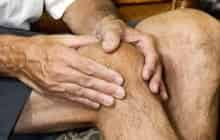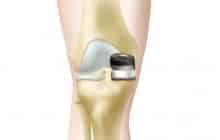
It’s among the most common concerns for pre-operative knee patients. To be honest, there’s not an awful lot a person with arthritic knees can do before knee replacement surgery to lessen postoperative pain. When joints are damaged to the extent they need replacement, the damage is irreversible and medications will do little but take the edge off the pain. Below are some of the factors that can influence postoperative pain after knee replacement surgery.
Before Surgery
It is said that losing weight (if you’re considerably heavy) or doing exercise (if you’re a couch potato) will lessen postoperative pain, but that’s not altogether true. Unless an overweight person can lose a considerable amount of weight in a healthy manner before surgery, it’s really not going to make a lot of difference to the outcome. Obese and considerably overweight people can have good outcomes just as much as thin and average weight people.
As for exercise, it is best to try and keep some tone and strength in the muscles, as fit muscles will recover better and more easily than will flabby ones. Prehabilitation (aka: prehab) is a method of physical preparation involving strength building and mobility improving exercises performed in the weeks leading up to your knee replacement surgery. But don’t ever force your arthritic joints to exercise if you experience pain doing so. The amount of painkillers you will have to take as a result can impact the effectiveness of pain medications after surgery.
During Surgery
The first principle of surgery is for surgeons to handle tissues gently, carefully and as little as possible. Surgeons who adhere to this credo will minimize postoperative pain and swelling, and lessen the risk of adhesions. This also applies to the gentle use of retractors and other surgical instruments, which might bruise and stretch the tissues. An equally important factor is that the wound be kept open for the shortest amount of time possible. This lessens moisture loss from the tissues, which if allowed to dry out can also increase pain, swelling and the risk of adhesions.
Your surgeon and the entire operating theater team must be very particular in aseptic technique, including the anesthetists and orderlies. Breaches of this discipline can lead to infection, which is a very painful thing.
If your surgeon chooses to use a tourniquet (used to control bleeding during surgery), pain at the site of the tourniquet can be a factor in the first few days after surgery. Tourniquets can also contribute to post op swelling, and many surgeons have stopped using them in favor of taking more time with hemostasis (stopping bleeding). However, this extra time might also have the disadvantage of issues as described above.
After Surgery
Once surgery is complete, the primary tools for controlling pain are simple: Rest, Elevate, Ice, and take pain medications as prescribed by your doctor.
Rest – for the first couple of weeks after surgery your only job is to rest…making trips as necessary to the bathroom or kitchen. Gentle heel slides and short walks are all that are required at this point. Do not get anxious about your flexion (range of movement), as it will decrease at this stage because the postoperative swelling may get worse and sometimes quite extreme. Your knee cannot bend when it is grossly swollen, but it doesn’t mean it will stay that way. The bend is there; it’s just blocked by the swelling. As soon as the swelling reduces, the flexion and extension will begin returning. This can take 3-4 weeks.
The best thing you can do to manage swelling, as well as pain, is elevation and ice. Elevation requires a straight pile of pillows with nothing bunched up behind the knee. Pressure applied behind the knee can encourage clots and may delay the ability to extend your knee, meaning to put it out straight. As for the height, “toes above nose” is a good maxim.
Use ice as long as you want to…hours at a time is fine, provided that when the ice pack or cuff is fresh, you protect your skin from the fierceness of fresh ice with a pillowcase or similar cloth. Skin can get freezer burn!
Pain medications are essential at this stage. Take what you have been prescribed and take it religiously, especially before the pain starts up again. After 4 weeks or maybe more, you can start adjusting doses or timing, but in the early weeks stick with what works. There is no rush to be off the pain medications your doctor prescribed, so don’t be frightened by tales of people becoming addicts because of a few weeks taking prescribed pain relievers. You need them at this stage and should continue using them as prescribed for as long as 10-12 weeks if necessary, although towards the end, you might find yourself requiring less and less.
More about reducing pain after knee replacement surgery >>
Above all, be careful adding to your progression of activity during recovery and don’t expect to bounce back within a matter of days. The best thing you can do is remember you are not the arbiter of how things go, your knee is! Listen to your knee and you will do just fine.
Also see: Knee Replacement Recovery: Exercises & Physical Therapy After Surgery
Filed Under: Knee ReplacementPreparing for Knee ReplacementRecovering from Knee Replacement





